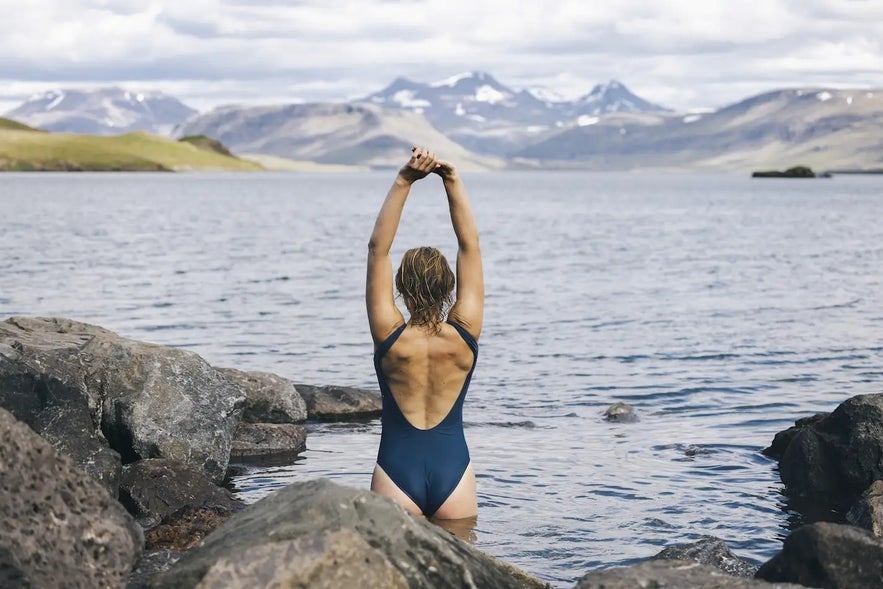Hvalfjörður to fiord w zachodniej Islandii. Ma około 30 kilometrów długości i 5 kilometrów szerokości, a na jego terenie znajdują się spa Hvammsvík Hot Springs oraz wodospad Glymur.
Hvalfjörður leży na zachodzie Islandii i ma około 30 kilometrów długości oraz 5 kilometrów szerokości. Fiord Hvalfjörður łączy w sobie spokojną, dziewiczą naturę z historycznym znaczeniem, dzięki czemu jest mniej uczęszczanym, ale bardzo atrakcyjnym miejscem dla miłośników pieszych wędrówek, przyrody i fotografii. Krajobraz fiordu tworzą małe jeziora, rzeki, wodospady i malownicze góry.
Dlaczego możesz nam zaufać
Guide to Iceland to najbardziej zaufana platforma turystyczna na Islandii, z której korzystają miliony odwiedzających każdego roku. Wszystkie nasze treści są tworzone i weryfikowane przez lokalnych ekspertów, doskonale znających Islandię. Możesz liczyć na rzetelne, aktualne i sprawdzone porady podróżnicze.
Mimo nazwy, która oznacza „Fiord Wielorybi”, Hvalfjörður nie jest znany z obecności wielorybów. Można tu jednak spotkać bogate życie ptaków oraz foki pospolite. Istnieją dwie teorie dotyczące pochodzenia nazwy: jedna mówi, że kiedyś fiord zamieszkiwały wieloryby, zanim ryby przeniosły się w inne rejony, druga – że nazwa pochodzi od charakterystycznego kształtu zatoki.
W okolicy nie brakuje atrakcji przyrodniczych, a najważniejszą z nich jest drugi co do wysokości wodospad Islandii – Glymur, zasilany przez rzekę Botnsá. W regionie znajduje się także wiele ciekawych szlaków pieszych, takich jak Sildarmannagötur prowadzący na północ czy Leggjabrjótur, który wiedzie na wschód w stronę Parku Narodowego Þingvellir. To doskonałe miejsce na wycieczki piesze, a pełny przegląd najlepszych tras znajdziesz w przewodniku po najpopularniejszych szlakach Islandii!
Najlepsze atrakcje w fiordzie Hvalfjörður

Kąpiel w Hvammsvík Hot Springs
Kąpiel w islandzkich gorących źródłach to bez wątpienia jedno z obowiązkowych doświadczeń podczas wizyty na wyspie. Hvammsvík Hot Springs w fiordzie Hvalfjörður oferuje osiem basenów z zapierającymi dech widokami na fiord i okolicę oraz możliwość spróbowania paddleboardingu, jogi, wędkowania, golfa, jazdy na rowerze, zwiedzania farmy, a nawet sesji metodą Wima Hofa dla odważnych. W pogodne zimowe noce ośrodek jest idealnym miejscem do podziwiania zorzy polarnej, gdy aktywność jest wysoka.
To, co wyróżnia Hvammsvík Hot Springs, to woda będąca mieszanką wód podziemnych i morskich, która zmienia się wraz z przypływami i porami roku – dzięki temu każda wizyta jest wyjątkowa. Na terenie ośrodka znajduje się także restauracja Stormur Bistro, serwująca sycące, lekkie dania przygotowane z lokalnych składników. Szczególnie polecamy zupę rybną, która cieszy się ogromną popularnością.
Jeśli chcesz przeżyć wyjątkową kąpiel w geotermalnych źródłach Hvammsvík i podziwiać niesamowite widoki, zarezerwuj bilet wstępu tutaj. Możesz także wykupić wejście do Hvammsvík Hot Springs wraz z transportem z centrum Reykjaviku.
Wędrówka do wodospadu Glymur
 Jedną z największych atrakcji fiordu Hvalfjörður jest Glymur – drugi najwyższy wodospad Islandii, spadający z wysokości 198 metrów. Szlak do Glymura prowadzi przez malowniczy kanion, jaskinie, rzeki i oferuje panoramiczne widoki na wodospad. Trasa z parkingu do Glymura ma około 7 kilometrów i jest umiarkowanie trudna.
Jedną z największych atrakcji fiordu Hvalfjörður jest Glymur – drugi najwyższy wodospad Islandii, spadający z wysokości 198 metrów. Szlak do Glymura prowadzi przez malowniczy kanion, jaskinie, rzeki i oferuje panoramiczne widoki na wodospad. Trasa z parkingu do Glymura ma około 7 kilometrów i jest umiarkowanie trudna.
Aby w pełni wykorzystać to wyjątkowe doświadczenie, możesz wybrać się na prywatną wycieczkę z przewodnikiem do wodospadu Glymur. Pamiętaj, że zimą szlak może być bardzo niebezpieczny, a nawet niemożliwy do przejścia ze względu na nieprzewidywalną pogodę, nierówne ścieżki i śliskie podłoże.
Polowanie na zorzę polarną w fiordzie Hvalfjörður
Fiord Hvalfjörður to idealne miejsce do obserwacji zorzy polarnej od końca września do początku kwietnia. Z dala od świateł miasta i zanieczyszczeń masz wyjątkową szansę zobaczyć to niezwykłe zjawisko na własne oczy.
Możesz wybrać się na poszukiwania zorzy samodzielnie, wynajmując samochód i śledząc prognozę zorzy dla Islandii, lub zarezerwować wygodną wycieczkę z przewodnikiem, który zabierze Cię w najlepsze miejsca.
Jak dojechać do fiordu Hvalfjörður

Tunel Hvalfjörður
Kiedyś podróż wokół fiordu Hvalfjörður wymagała pokonania około 62 kilometrów. Jednak otwarcie tunelu Hvalfjörður w 1998 roku znacznie skróciło trasę. Tunel ma długość 5,77 kilometra i biegnie pod fiordem, co znacząco skraca czas podróży i ułatwia dostęp do regionu zarówno mieszkańcom, jak i turystom. Przejazd tunelem Hvalfjörður jest bezpłatny.
Historia i kultura fiordu Hvalfjörður

Zdjęcie powyżej z Wikimedia, Creative Commons, autor Axel Kristinsson. Bez zmian.
Dziedzictwo II wojny światowej
Podczas II wojny światowej brytyjska i amerykańska marynarka wojenna zbudowały bazy wzdłuż fiordu Hvalfjörður ze względu na strategiczne położenie, które umożliwiało ochronę konwojów atlantyckich. Pozostałości z tamtego okresu, takie jak nabrzeża i inne obiekty, można zobaczyć do dziś.
Stacja wielorybnicza w fiordzie Hvalfjörður
W fiordzie Hvalfjörður znajduje się pierwsza islandzka stacja wielorybnicza, zbudowana w 1948 roku na Midsandur. Stacja działa do dziś i przypomina o historii połowów wielorybów w islandzkiej kulturze morskiej, choć temat ten budzi wiele kontrowersji.
Znani mieszkańcy fiordu Hvalfjörður
W fiordzie Hvalfjörður mieszkał najsłynniejszy islandzki poeta psalmów, Hallgrímur Pétursson. To także rodzinne strony zmarłego Sveinbjörna Beinteinssona – poety, artysty i głowy Islandzkiego Stowarzyszenia Pogańskiego.
Zakład przemysłowy Grundartangi
W Grundartangi, w fiordzie Hvalfjörður, znajduje się jeden z największych portów w kraju oraz dwa zakłady przemysłowe. Jeden to fabryka ferrosilikonu, działająca od 1979 roku, a drugi to huta aluminium, otwarta w 1998 roku. Oba zakłady budziły kontrowersje już podczas budowy i nadal są przedmiotem debat ekologicznych. Podobnie jak połowy wielorybów i elektrownie wodne, huty i fabryki silikonu to jedne z najgorętszych tematów środowiskowych na Islandii.









